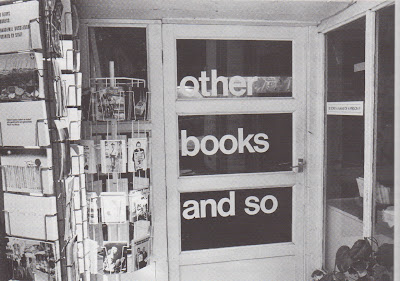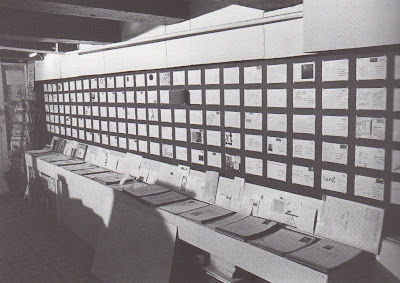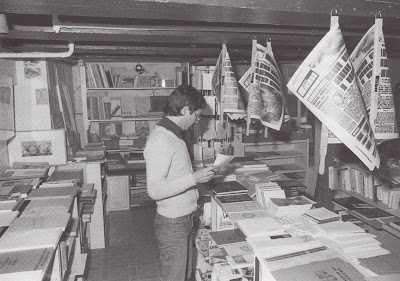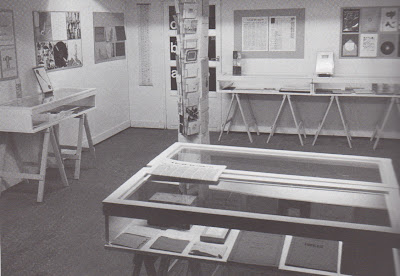
Below are excerpts from Ulises Carrión's influential text "The Art of Making Books", from 1975, and images from Other Books and So, which he founded in Amsterdam that same year, and which continued until 1979. The project then ceased to exist as a gallery and bookstore, but continued on as an archive. Carrion died in 1989, from AIDS, at the age of 49.
The full essay is reprinted in Joan Lyons' ARTISTS' BOOKS: A Critical Anthology And Sourcebook, and in Guy Schraenen's Ulises Carrión. We have won! Haven't we?.

What a Book Is
A book is a sequence of spaces. Each of these spaces is perceived at a different moment - a book is also a sequence of moments. A book is not a case of words, nor a bag of words, nor a bearer of words.
A writer, contrary to the popular opinion, does not write books. A writer writes texts. The fact, that a text is contained in a book, comes only from the dimensions of such a text; or, in the case of a series of short texts (poems, for instance), from their number.
A literary (prose) text contained in a book ignores the fact that the book is an autonomous space-time sequence.
A series of more or less short texts (poems or other) distributed through a book following any particular ordering reveals the sequential nature of the book. It reveals it, perhaps uses it; but it does not incorporate it or assimilate it.
In the old art the writer judges himself as being not responsible for the real book. He writes the text. The rest is done by the servants, the artisans, the workers, the others. In the new art writing a text is only the first link in the chain going from the writer to the reader. In the new art the writer assumes the responsibility for the whole process.
In the old art the writer writes texts.In the new art the writer makes books. To make a book is to actualize its ideal space-time sequence by means of the creation of a parallel sequence of signs, be it linguistic or other.


PROSE AND POETRY
In an old book all the pages are the same. When writing the text, the writer followed only the sequential laws of language, which are not the sequential laws of books. Words might be different on every page; but every page is, as such, identical with the preceding ones and with those that follow. In the new art every page is different; every page is an individualized element of a structure (the book) wherein it has a particular function to fulfill.
In spoken and written language pronouns substitute for nouns, so to avoid tiresome, superfluous repetitions.
In the book, composed of various elements, of signs, such as language, what is it that plays the role of pronouns, so to avoid tiresome, superfluous repetitions? This is a problem for the new art; the old one does not even suspect its existence.
A book of 500 pages, or of 100 pages, or even of 25, wherein all the pages are similar, is a boring book considered as a book, no matter how thrilling the content of the words of the text printed on the pages might be.
A novel, by a writer of genius or by a third-rate author, is a book where nothing happens. There are still, and always will be, people who like reading novels. There will also always be people who like playing chess, gossiping, dancing the mambo, or eating strawberries with cream.
In comparison with novels, where nothing happens, in poetry books something happens sometimes, although very little.
A novel with no capital letters, or with different letter types, or with chemical formulae interspersed here and there etc., is still a novel, that is to say, a boring book pretending not to be such.
A book of poems contains as many words as, or more than, a novel, but it uses ultimately the real, physical space whereon these words appear, in a more intentional, more evident, deeper way. This is so because in order to transcribe poetical language onto paper it is necessary to translate typographically the conventions proper to poetic language.
The transcription of prose needs few things: punctuation, capitals, various margins, etc. All these conventions are original and extremely beautiful discoveries, but we don't notice them any more because we use them daily. Transcription of poetry, a more elaborate language, uses less common signs. The mere need to create the signs fitting the transcription of poetic language, calls our attention to this very simple fact: to write a poem on paper is a different action from writing it on our mind.
Concrete poetry represents an alternative to poetry.
Books, regarded as autonomous space-time sequences offer an alternative to all existent literary genres.
What is more meaningful: the book or the text it contains? What was first: the chicken or the egg?
The objective manifestation of language can be experienced in an isolated moment and space - the page; or in a sequence of spaces and moments - the book.

THE LANGUAGE
Language transmits ideas, i.e. mental images. The starting point of the transmission of mental images is always an intention: we speak to transmit a particular image. The everyday language and the old art language have this in common: both are intentional, both want to transmit certain mental images.
In the old art the meanings of the words are the bearers of the author's intentions. Just as the ultimate meaning of words is indefinable, so the author's intention is unfathomable.
New art's language is radically different from daily language. It neglects intentions and utility, and it returns to itself, it investigates itself, looking for forms, for series of forms that give birth to, couple with, unfold into, space-time sequences.
The words in a new book are not the bearers of the message, nor the mouthpieces of the soul, nor the currency of communication. Those were already named by Hamlet, an avid reader of books: words, words, words.
The words of the new book are there not to transmit certain mental images with a certain intention. They are there to form, together with other signs, a space-time sequence that we identify with the name 'book'.
The words in a new book might be the author's own words or someone else's words. A writer of the new art writes very little or does not write at all.
The most beautiful and perfect book in the world is a book with only blank pages, in the same way that the most complete language is that which lies beyond all that the words of a man can say.
Every book of the new art is searching after that book of absolute whiteness, in the same way that every poem searches for silence.
Intention is the mother of rhetoric.
Words cannot avoid meaning something, but they can be divested of intentionality.
A non-intentional language is an abstract language: it doesn't refer to any concrete reality. Paradox: in order to be able to manifest itself concretely, language must first become abstract.
Abstract language means that words are not bound to any particular intention; that the word 'rose' is neither the rose that I see nor the rose that a more or less fictional character claims to see. In the abstract language of the new art the word 'rose' is the word 'rose'. It means all the roses and it means none of them.
How to succeed in making a rose that is not my rose, nor his rose, but everybody's rose, i.e. nobody's rose? By placing it within a sequential structure (for example a book), so that it momentarily ceases being a rose and becomes essentially an element of the structure.

STRUCTURES
Every word exists as an element of a structure - a phrase, a novel, a telegram. Or: every word is part of a text.
Nobody or nothing exists in isolation: everything is an element of a structure. Every structure is in its turn an element of another structure. Everything that exists is a structure. To understand something, is to understand the structure of which it is a part and/or the elements forming the structure that that something is.
A book consists of various elements, one of which might be a text. A text that is part of a book isn't necessarily the most essential or important part of that book.
A person may go to the bookshop to buy ten red books because this colour harmonises with the other colours in his sitting room, or for any other reason, thereby revealing the irrefutable fact, that books have a colour.
In a book of the old art words transmit the author's intention. That's why he chooses them carefully. In a book of the new art words don't transmit any intention; they're used to form a text which is an element of a book, and it is this book, as a totality, that transmits the author's intention.
Plagiarism is the starting point of the creative activity in the new art.
Whenever the new art uses an isolated word, then it is in an absolute isolation: books of one single word.
Old art's authors have the gift for language, the talent for language, the ease for language. For new art's authors language is an enigma, a problem; the book hints at ways to solve it.
In the new art you don't love anybody. The old art claims to love. In art you can love nobody. Only in real life can you love someone. Not that the new art lacks passions. All of it is blood flowing out of the wound that language has inflicted on men.
And it is also the joy of being able to express something with everything, with any thing, with almost nothing, with nothing.
The old art chooses, among the literary genres and forms, that one which best fits the author's intention. The new art uses any manifestation of language, since the author has no other intention than to test the language's ability to mean something.
The text of a book in the new art can be a novel as well as a single word, sonnets as well as jokes, love- letters as well as weather reports.
In the new art the reading itself proves that the reader understands.

THE READING
In order to read the old art, knowing the alphabet is enough. In order to read the new art one must apprehend the book as a structure, identifying its elements and understanding their function.
One might read old art in the belief that one understands it, and be wrong. Such a misunderstanding is impossible in the new art. You can read only if you understand.
In the old art all books are read in the same way. In the new art every book requires a different reading.
In the old art, to read the last page takes as much time as to read the first one. In the new art the reading rhythm changes, quickens, speeds up.
In order to understand and to appreciate a book of the old art, it is necessary to read it thoroughly. In the new art you often do NOT need to read the whole book. The reading may stop at the very moment you have understood the total structure of the book,
The new art makes it possible to read faster than the fast-reading methods. There are fast-reading methods because writing methods are too slow. To read a book, is to perceive sequentially its structure. The old art takes no heed of reading.
The new art doesn't discriminate between its readers; it does not address itself to the book-addicts or try to steal its public away from TV.
In order to be able to read the new art, and to understand it, you don't need to spend five years in a Faculty of English.

The business idea you can improve a business and the better decision and visit the website to get useful material for all students. From this work of the enterprise, you can improve a business for the children.
ReplyDeleteThe company concept you are able to enhance a company and also the much better choice as well as go to this website to obtain helpful materials for those college students. Out of this function from the business, you are able to enhance a company for that kids.
ReplyDeleteCreating a book is really a huge art which everyone cannot do. There has people who can write things but cannot make a book. this website to check out more helpful guide and tips for writing your papers.
ReplyDeleteThere are different kind of people in this world but I must say you guys are really talented and this site always helped me in completing my work.Thanks a lot.
ReplyDeleteFirst time I am reading about data entry work topic in context of fraud but I would like to check more info about this.Anyways this is really nice content.Thank you.
ReplyDeleteMaking a publication can be a massive fine art which usually every person can not carry out. There has those who can easily compose items yet can not produce a publication. this amazing site to see a lot more http://www.besttypingservices.net/areas-we-serve-in/ beneficial information and also methods for creating the paperwork
ReplyDelete